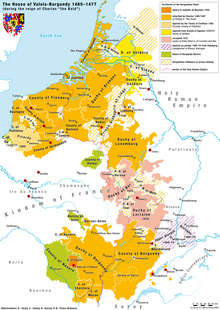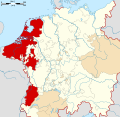County of Burgundy
This article needs additional citations for verification. (June 2023) |
Free County of Burgundy | |||||||||||
|---|---|---|---|---|---|---|---|---|---|---|---|
| 982–1678 | |||||||||||
Heraldic flag since the 16th century | |||||||||||
 County of Burgundy at the end of the 15th century. | |||||||||||
| Status | Part of Upper Burgundy and the Kingdom of Arles, then state of the Holy Roman Empire | ||||||||||
| Capital | Dole | ||||||||||
| Religion | Catholicism | ||||||||||
| Government | Feudal monarchy (County) | ||||||||||
| Historical era | |||||||||||
| 982 | |||||||||||
| 1033 | |||||||||||
| 1384 | |||||||||||
| 1493 | |||||||||||
• Joined Burgundian Circle | 1512 | ||||||||||
| 1678 | |||||||||||
| |||||||||||
The Free County of Burgundy (French: Franche Comté de Bourgogne; German: Freigrafschaft Burgund) was a medieval feudal state ruled by a count from 982 to 1678. It was also known as Franche-Comté, from French: franc comte meaning 'free count', and was located in the modern region of Franche-Comté. It bordered the Duchy of Burgundy to the west, which was part of France from 843.
The territory had previously been part of the kingdom of Upper Burgundy (888–933). The county was formed in 982 by Otto-William for the lands he held in the Kingdom of Arles (outside the duchy's borders). In 1032 the Kingdom of Arles was inherited by Conrad II, Holy Roman Emperor, who incorporated the County of Burgundy into the Holy Roman Empire (HRE). The county briefly gained independence in the 12th century, before being re-incorporated into the empire by Frederick Barbarossa.
As a state of the HRE, the county was granted a high degree of autonomy. The largest city, Besançon, was granted the status of free imperial city. The rest of the county was given imperial immediacy (making it an imperial county) and its rulers were given the title of Freigraf (German for 'free count'), from which the French and English names of the county are derived.
From 1295 the county began to fall under the increasing influence of France and the House of Burgundy, which ruled the duchy. From 1330 to 1361 and again from 1405 to 1477, there was a personal union between the county (part of the HRE) and the adjacent duchy (part of France). In 1493 the county was transferred to the House of Habsburg, which ruled it until it was conquered by France in 1674. French rule was made permanent by the Treaties of Nijmegen in 1678.
Formation within the kingdom of Arles
[edit]The area previously formed part of the Kingdom of the Burgundians, which had been annexed by the Franks in 534 and incorporated into the Kingdom of the Franks. The Empire was partitioned in 843 by the Treaty of Verdun, with the area west of the Saône river being allotted to West Francia as the French Duchy of Burgundy, while the southern and eastern parts of the former Burgundian kingdom fell to Middle Francia under Emperor Lothair I. This Middle Frankish part became the two independent entities of southern Lower Burgundy in 879 and northern Upper Burgundy under King Rudolph I in 888. The region that would become Franche-Comté was then included in Upper Burgundy, centred around the city of Besançon. In 933, with the collapse of the Carolingian Empire, Lower and Upper Burgundy were re-united under King Rudolph II[1] as the Kingdom of Arles (Arelat).
In 982, Otto-William (son of Adalbert of Lombardy) married Ermentrude of Roucy. Ermentrude was a widow, whose previous husband was had been count of Mâcon (in the Duchy of Burgundy) and controlled additional lands around Besançon and Dole. These lands were then ruled by Otto-William in right of his wife. Otto-William was already the adopted heir of Henry I, Duke of Burgundy, so expected to inherit the entire duchy when Henry died. The lands outside the duchy, that Otto-William had acquired through Ermentrude, were organised as the new County of Burgundy.
Henry I died in 1002, at which point Otto-William claimed the Duchy of Burgundy. However, king Robert II of France refused to recognise the adoption and claimed the duchy as the nephew of Henry I. This started a war between the two claimants. After a few years of conflict,[2] Robert II prevailed in the duchy; he would later grant it to his son Robert I, Duke of Burgundy, keeping the Crown of his elder son Hugues. Otto-William remained in control of the county of Mâcon, and therferore strengthened its grip in the County, fief of the Kingdom of Burgundy.

Otto-William and Ermentrude became the progenitors of the Anscarid dynasty. The development of commercial routes across the Jura mountains and the development of salt mines assured the prosperity of the county, and for several decades its towns preserved their freedom and neutrality.
As part of the Holy Roman Empire
[edit]
The Arelat kingdom collapsed with the extinction the ruling line in 1032. The Kingdom of Burgundy was inherited by the Holy Roman Emperor Conrad II of the Salian dynasty, while the Duchy of Burgundy returned to a cadet branch of the French Capetian dynasty. As a result, the County of Burgundy became a fief of the Holy Roman Empire.[3]
At the end of the 11th century Conrad's son Emperor Henry III elevated the Archbishop of Besançon to the dignity of an archchancellor and conferred upon Besançon the rank of a Reichsstadt (imperial city) under the Emperor's direct patronage. Guy of Burgundy, brother of Renaud II, later became pope and negotiated the Concordat of Worms with Emperor Henry V. In the 12th century, Imperial protection allowed for the development of Besançon, but in 1127, after the assassination of William III, his cousin Renaud III shook off the Imperial yoke[4] and refused to pay homage to Lothair III (at the time still Lothair II of Germany). After 10 years of conflict, Renaud was victorious. Burgundy was from then on called Franche-Comté, the "free county".[4]
Emperor Frederick Barbarossa re-established imperial influence. Frederick took the brother[who?] of Count William IV prisoner, then when William died Frederick married William's niece and heir, Beatrice I (daughter of Renaud III). Upon Emperor Frederick's death in 1190, his younger son Otto I received the county of Burgundy and assumed the rare (possibly unique) title of archcount. He was succeeded by his daughter, Beatrice II, and her husband Otto I, Duke of Merania; they were in turn followed by their son, Otto III, Count of Burgundy (r. 1231–1238), and their daughter, Adelaide (alias Alix of Méran, r. 1248–1279).[5]
The Counts Palatine[which?] for many years had to share power with the greater feudal families of the county, notably with the family of Chalon, which was descended from Stephen III, count of Auxonne, grandson of William IV and Beatrice of Thiern, the heir of the county of Chalon. In 1237, count John "the Old" of Chalon, transferred his possessions under the French Crown (including Chalon and Auxerre) to the Duke of Burgundy in exchange for wealthy possessions in the County of Burgundy, including the salt mines of Salins-les-Bains[5] (which became the autonomous Seigneurie of Salins). The authority of John the Old was re-established only by the marriage (around 1239) of his oldest son Hugh of Chalon with Adelaide, the sister of Otto III (died 1248) and heiress of Burgundy.[5] However, this did not prevent a younger son, John I of Chalon-Arlay, from taking control of the vassal states.
Otto IV, son of Hugh and Adelaide, was the last of the feudal counts of Burgundy. He married first the daughter of the Count of Bar, but the marriage was childless. His second marriage was to the grandniece of King Louis IX of France, Countess Mahaut of Artois. This marriage brought the county under French influence. The daughters of Otto IV and Mahaut, Joan II and Blanche, married respectively Philip V and Charles IV of France, sons of King Philip IV. Jeanne became Queen of France after having been involved in the Tour de Nesle Affair. In that same affair, Blanche was found guilty of adultery and was imprisoned for the rest of her life.
Burgundian unions
[edit]
After quarrelling with his barons, and after a new revolt against the French carried out by John of Chalon-Arlay, Otto IV ceded the county to his daughter as a dowry and designated the King of France as administrator of the dowry in 1295. By marrying their daughter and heir Joan, Duke Odo IV of Burgundy reunited the duchy and the county under his rule, followed by his grandson Duke Philip I. The personal union was again broken when Philip died without heirs in 1361: the Duchy of Burgundy was seized as a reverted fief by King John II of France, while the Imperial county was inherited by Philip's great aunt Margaret I, a granddaughter of Count Otto IV. In 1382, she bequeathed her estates to her son Count Louis II of Flanders. During the reign of Phillip the Bold, the County was organized into having a council and a parliament — centered in the capital Dole.[3]
Louis II died in 1384 leaving no male heirs, so the County of Burgundy formed part of the immense dowry of his daughter Margaret, which in 1405 was inherited by her son, the Burgundian duke John the Fearless. The county and the duchy were again ruled in personal union by his descendants from the House of Valois-Burgundy until the death of Duke Charles the Bold at the 1477 Battle of Nancy. His cousin King Louis XI of France immediately occupied the county, but Archduke Maximilian I of Habsburg opposed this action, because he was the husband of Charles' daughter Mary the Rich. Though defeated at the 1479 Battle of Guinegate, the French retained the county.
Spanish possession
[edit]Louis' successor King Charles VIII of France, wishing to be free of conflicts over the county in order to intervene in Naples, again ceded it to Emperor Maximilian and his son Philip I of Castile by the 1493 Treaty of Senlis. From that point onwards, the County of Burgundy was ruled by Habsburg Spain, who administered it as part of the Habsburg Netherlands. The Spanish Road trade route ran through the county, connecting the various Spanish possessions in the region. As such it was very important militarily.
During Spanish rule, the County was prosperous and had autonomy. Dole's parliament was the political center, and a governor was chosen from the local nobility. Taxes to Spain were low, and there was not much conscription either. The city of Besancon had many fairs and many renaissance structures were constructed.[3]
The county was invaded by France in 1668, as part of the War of Devolution. Multiple cities surrendered to the French after little fighting, but were returned as part of the wider Treaty of Aix-la-Chapelle later that year.
Conquest by France
[edit]France invaded again in 1674, as part of the Franco-Dutch war, again overrunning the country with little resistance. The Treaties of Nijmegen ended the war in 1678; as part of the third treaty (between France and Spain), the county was transferred to France in exchange for the return of French-occupied territory in the Spanish Netherlands.
The territory of Franche-Comté has remained part of France uninterrupted ever since; it now forms part of the administrative region Bourgogne-Franche-Comté.
See also
[edit]References
[edit]- ^ Rolf Grosse (2014). Du royaume franc aux origines de la France et de l'Allemagne 800-1214. Presses Universitaires du Septentrion.
- ^ Raphaël Bijard (2021). "La construction de la Bourgogne Robertienne (936 - 1031)". Academia.
- ^ a b c "Franche-Comté Region of France - History". Regions of France. Retrieved 2024-02-12.
- ^ a b "Franche-Comte | History, Culture, Geography, & Map | Britannica". www.britannica.com. Retrieved 2024-02-12.
- ^ a b c "Chalon". Encarta Encyclopedie Winkler Prins (in Dutch). Microsoft Corporation/Het Spectrum. 2002.
External links
[edit]- The History Files: Frankish Kingdom of Burgundy


 French
French Deutsch
Deutsch

